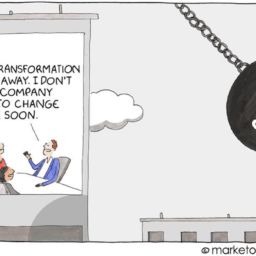
Many companies aspire to be innovative. In a fierce battle for top talent, especially when recruiting Millennials and Centennials, even legacy organizations attempt to promote themselves as the next Google, Amazon or Uber, albeit often with limited success.
During the dot-com bubble, companies were replete with ping-pong tables, colorful sofas and other accouterments of the era, again trying to cast themselves as different…as innovative. Other established companies have similarly followed suit. Open floor plans and relaxed gathering areas can, in fact, enhance teamwork, and companies should look to employ such facilities where applicable, but all the playful and colorful furnishings in the world won’t, by themselves, induce innovation.
Innovation is a byproduct of an environment in which people are encouraged, unencumbered, and in fact rewarded for being creative.
Leadership philosophy, structure and style are, of course, critical to creating an environment that’s conducive to innovation. As a colleague once told me, there is no playbook for innovation, per se, but rather leaders who create the conditions for the “crazy ones” to thrive! A strong and well-articulated leadership vision is invaluable. In contrast, a rigid command-and-control management structure that seeks to drive a singular, top-down vision that does not invite debate or open ideation is usually not successful in inspiring an innovative culture. Moreover, such a structure rarely identifies and rallies around new ideas that may originate from deep within an organization, since they may not get adequate visibility.
It must be noted, too, that management does not necessarily equate to leadership and, similarly, innovation does not necessarily follow a hierarchical path. Further, overwhelming bureaucracy and process all but kills innovation, so leaders must look to remove such encumbrances.
Software development, for example, is largely a right-brain activity: it’s a creative outlet. It’s no accident that there’s a high correlation between talented software developers and musicians. Personally, I’ve always found a certain rhythm to coding. Yet, when organizations impose too much process, paperwork and bureaucracy, often under the auspices of a software development lifecycle or risk mitigation, they essentially turn these same software developers, some of whom they depend on to drive creativity and innovation, into “accountants”.
That’s no knock on accountants: we live in the real world and financial support and oversight is important! Nonetheless, too many procedural left brain activities imposed on those with a natural creative orientation, reflecting the instincts of right brain individuals, risks innovation.
Failure is also a part of innovation. Pursuing new ideas towards a successful outcome is difficult: many, if not most new ideas will fail. An environment that encourages innovation must also therefore allow for, and anticipate failure. Optimally, organizations must be structured to be nimble, so that they can fail fast. This extends to dependencies on associated support functions, like infrastructure, which must be managed to be commercially viable and competitive. For example, incurring a tremendous capital expenditure and timeframe to bring new infrastructure online is not consistent with a nimble, fail-fast environment.
Also, while leaders may be reluctant to vacate an initiative that appears to be heading in the wrong direction, this is not always the right course. At times, such leadership is absolutely warranted, if not admirable, as an initiative may take longer than expected to achieve its promise or to convince others of its merit. It’s important to ensure that such decisions, however, are not based on personal hubris or the need to justify whatever political and financial capital has already been invested. After all, such failures are usually highly visible to rank-and-file staff, so continued pursuit may actually have the adverse effect of draining leadership credibility.
While success should certainly be rewarded, effort must also be acknowledged, even when an initiative fails. An inability to do so will quell the necessary risk-taking that accompanies innovation, as staff are otherwise incented to take the safe route, which is often representative of the status quo.
Further, innovation is often based on certain convictions that may be hard to quantify with traditional metrics, particularly in the early stages. In some cases, the success or failure of an initiative may take some time to materialize, especially when an innovation defines a new category or requires a significant organizational, or market transition. Therefore, imposing traditional financial metrics on early-stage innovation may not be wise. Indeed, there’s plenty of evidence to suggest that some of the most successful, innovative products and services were never forecast to be so at the outset. Necessity is often the mother of invention, and frequently innovations are initially focused to meet an internal, unfulfilled need, well before they gain substantial market acclaim and financial success.
Talent, of course, is another critical element towards achieving innovation. It is the job of leaders to assemble, develop and maximize the impact of such talent while pursuing the overarching objectives of the organization…recognizing that those objectives, themselves, may be subject to change. Some organizations, often under the pressure of managing expenses, seek to utilize unit cost as a key performance indicator of talent management. While this is a readily quantifiable metric, it grossly oversimplifies an organization’s true talent quotient and implies that talent is a commodity: it is not.
So-called “athletes” often produce at a multiplier that is several times greater than their unit cost might suggest. For example, a resource who can consistently produce at a 3x rate, yet is compensated at 2x the average unit cost, is a great resource! To that point, total cost of ownership and margin are much better indicators of talent efficacy, since they are more directly aligned with the P&L of a business and also attempt to incorporate some measure of productivity.
Innovation is disruptive and often messy. It challenges the status quo, which may itself introduce additional leadership hurdles, as some staff may feel their own careers are threatened. This is especially true in organizations with various legacy functions, or mature businesses. Yet, leaders who seek to create a culture of innovation must not allow such feelings to dictate the agenda, and must instead find ways in which to effectively educate and transition their staff. Ultimately, innovation is Darwinian and those who adapt to change are more likely to have longer, more successful careers. It is often worthwhile for leaders to share this truth with their staff. Similarly, innovative companies must be willing to cannibalize their own existing businesses, or they themselves may ultimately be cannibalized.
In my career, I’ve been fortunate to be a part of some innovations that have sometimes – though certainly not always – led to successful new products and services. Those that succeed are often highly organic, driven by people with tremendous conviction, even as their ideas may be questioned. I would never counsel leadership to get out of the way and simply promote a free-for-all, but rather to help create, and to continually refine an environment that drives an innovative, more entrepreneurial culture.
In no particular order, this includes the ability to articulate a vision; to allow others to own the vision; to encourage active participation and input at all levels; to allow for experimentation and failure; to reduce bureaucracy and other encumbrances; to attract and retain top talent; to enhance the organization’s brand; to be willing to change course; to be willing to cannibalize existing capabilities and businesses; and to celebrate and reward effort, as well as success.
It is remarkable what talented and empowered people can accomplish, but it often starts with the right cultural edifice.












